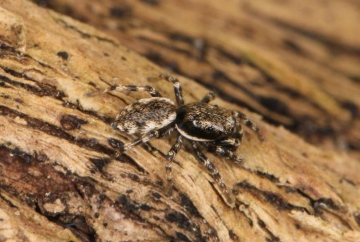Species Account for Salticus zebraneus
Salticus zebraneus (C.L.Koch, 1837)
Araneae: Salticidae

Reproduction for study and non-profit use permitted, all other rights reserved.
Taxonomic group: spiders (Araneae) - County data
View time series maps for Salticus zebraneus
member log-on for taxon report
Status: NS
Essex RDB: Listed
Threat: Regionally Important
Images
upload a new image
National map for Salticus zebraneus on Spider and Harvestman Recording Scheme website
Species text
The jumping spider Salticus zebraneus occurs on old tree trunks, especially those with strongly textured bark or with lichen growth. It was formerly only known from seven sites in Hampshire, Sussex, Surrey and Kent (Merrett 1990), but the species is now recorded from a number of new sites in Essex, Berkshire, Hertfordshire (and London) and Worcestershire. Records in Essex indicate that the species, whilst rare, may be over-looked and hence more widespread in southern England than present records suggest. The spider may be numerous in favourable conditions, but is more often found as singletons or in small numbers. To some extent this may be due to its cryptic habits.
Although described as mainly found on the trunks of pine trees (Roberts, 1995) many recent records are from old oak trunks at the edge of ancient woodland, in pasture woodland and hedgerows and on old willow trunks. Most records have been from mature trees in open woodland habitat or at the edge of clearings. The spider has also been found on an old oak trunk between arable fields in South Essex and on an old oak trunk in parkland converted to arable in Worcestershire (Alexander 1995). It has even been found on a number of occasions on an old lime trunk in a suburban garden at Surbiton, Surrey originally part of an old estate. The spider is very well camouflaged and can rapidly hide in fissures and crevices or under loose bark. The texture and structure of the bark is probably more important than the particular type of tree and all old trunks with fissured bark are worth investigation. The spider is most easily seen when it moves around on the surface of bark in sunshine.
Lack of management resulting in the closure of open woodland and the loss of old trees and ancient woodland are almost certainly detrimental to this species. Spray drift from the use of pesticides on crops is likely to affect the survival of this spider, as well as many other invertebrates, where old oak trees occur in land converted to arable or in old hedgerows adjacent to arable fields. Old tree trunks are a typical habitat for this rare species, and large trees with trunks exposed to the sun should be retained. Management should retain open surroundings by rotational cutting of woodland ride vegetation, periodic control of scrub and tree invasion and light grazing in woodland pasture. The retention of wide field edges and headlands should be encouraged to help maintain a diverse invertebrate fauna and reduce the effects of spray drift. References
Habitats
Recorded management for locations with Salticus zebraneus
Recorded substrate and hydrology for locations with Salticus zebraneus
Why not join the Club, register and add a new species page
Interpretation of distribution maps























